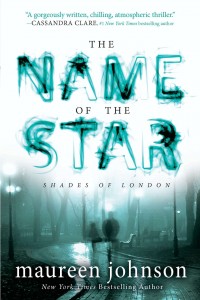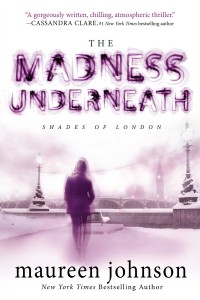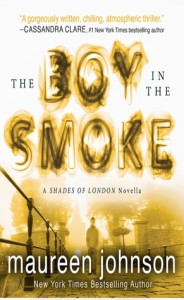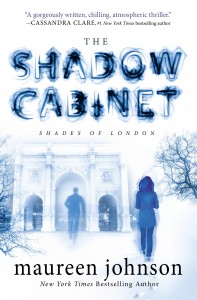The actual title of this post should be “Books 1-3 plus that novella that came out in 2014,” but that was rather inelegant.
 The Name of the Star
The Name of the Star
When Louisiana native Rory Deveaux’s professorial parents take a sabbatical in the UK, Rory jumps at the chance to attend boarding school in London. The early chapters of The Name of the Star depict her acclimation to life at Wexford, befriending her new roommate (Jazza) and developing a flirtation with one of the male prefects (Jerome). Because the phrase “boarding school in London” is totally my cup of tea (har har) and because Rory is amusingly snarky, I was already loving the book at this point, and that’s before I even got to the part with Jack the Ripper and ghosts!
A copycat of the notorious killer is on the loose, and since Wexford is located in Whitechapel, many of the crime scenes are nearby. After a near-death experience by choking grants Rory the ability to see ghosts, she actually witnesses the perpetrator (who has mysteriously failed to show up on any CCTV recordings of the murders) which brings her to the notice of a special secret police squad tasked with controlling any unruly members of the spectral population.
Several more fun characters are then introduced, and here I must compliment the narrator of the unabridged audiobook, Nicola Barber, whose facility in accents made me feel like I was listening to a BBC show. (I especially liked that Callum, a former football hopeful now dispatching meddlesome ghosts on the Underground, sounded rather like Lister from Red Dwarf!) In fact, I think this would make a pretty great BBC show, with its mildly diverse cast and the fact that the heroine is not merely brave (she eventually assists the squad in their ghosthunt), but funny, too. Admittedly, there were a couple of moments where Rory did some dumb things, but one could argue she didn’t really have better alternatives.
I haven’t loved a book this much in quite a long time, and I am both happy and bummed that there are two more (only two more!) in the series currently.
 The Madness Underneath
The Madness Underneath
It is with true regret that I must report that The Madness Underneath suffers from an unfortunate case of Middle Book Syndrome. A crack created at the end of the first book seems to be providing a way for the buried dead of Bedlam to make it to the surface, and Rory’s newfound skills as a human “terminus” are effective in dispatching one murderous ghost, but this plotline fizzles out partway through. (Sidebar: it’s a crazy coincidence that this article comes out the very day I finish this book!) Then Rory falls in with a cult whose philosophy and goals don’t make a lot of sense, and shortly after her costly rescue, there’s suddenly a cliffhanger ending. If I had to wait for book three, I would probably be peeved that that’s all there was.
That is not to suggest that nothing of merit happens, however. I actually really liked how Rory’s return to Wexford was handled—how she was just simply incapable of caring about things she used to care about. So far behind in schoolwork that it’s overwhelming, she can’t muster the desire to try, and yet is blindsided when it is suggested that perhaps she ought to withdraw prior to exams. So caught up in the ghosthunting gig, boyfriend Jerome’s suspicions (and then guilt over same) become just another nagging problem, so she ends their relationship. I liked that Callum feels more antagonistically towards ghosts than the others do, and yet everyone seems to respect each other’s point of view. I liked the Marc Bolan reference. And, of course, before the more serious stuff starts to happen, there are at least a dozen lines of dialogue that made me laugh. (There’s also a dream featuring ham lunchmeat that I think might be an homage to the Buffy the Vampire Slayer episode “Restless.”)
Even though this particular installment was kind of disappointing, I continue to look forward to subsequent books just as much as before.
 The Boy in the Smoke
The Boy in the Smoke
This short novella visits four defining moments in the life of Stephen Dene, leader of the ghost police, offering insight into the thoughts and background of a notably reticent character. Some of these incidents have been referred to in previous books, but not in this much detail.
“The Forgotten Boy” recounts a time when Stephen’s parents forget to fetch him from school at the end of term. (They’ve gone to Barbados instead.) His sister Regina comes to his rescue, determined to save him from a life doing what their parents expect, but she’s erratic and Stephen soon figures out that she’s using drugs. In “The Break in the Chain,” Stephen is attending Eton when he gets word of Regina’s death by overdose. (His parents “worked out their grief at a resort in Switzerland.”) He manages to carry on for several years, determined to fulfill his duty of succeeding at Eton and carrying on to Cambridge, until a visit from his unfeeling family leads him to commit suicide (in a scene that is absolutely riveting).
“The Specialist” find Stephen recovering at a psychiatric hospital and being recruited by Thorpe to lead the reformed team. And in “The Boy in the Smoke,” Stephen has finally achieved his dream of becoming a police officer. Practically the first thing he does is search for Regina’s ghost, only to find she did not return. Lastly, he fulfills his promise to come back to visit the ghost who saved his life and this slim little book comes to an end that left me rather verklempt.
Is this book essential to understanding the Shades of London series? No, but I’d say it’s essential to understanding Stephen, and very definitely worth the time.
 The Shadow Cabinet
The Shadow Cabinet
What do you get when you take a series that first beguiled me with London, boarding school, Jack the Ripper, and ghosts, and then remove half of those things? A book that is reasonably good but which I just cannot love with anything approaching the ardor I originally felt.
The Shadow Cabinet offers a lot more information about the cult and their goals, introduces the concept of powerful stones that prevent London from being overrun by spirits as well as a secret society tasked with protecting them, and unleashes creepy, evil siblings Sid and Sadie upon the world. More attention, though, is devoted to Rory’s personal plight. Now in hiding from family and friends after running away from Wexford, she and the team are searching everywhere for one of their own who they believe has become a ghost.
The resolution to book two’s cliffhanger is pretty satisfying, I must admit, and I found that I did care a lot about whether certain characters made it out of Sid and Sadie’s proximity unscathed. I also really liked getting to know more about Thorpe, the group’s MI-5 overseer, and that Rory apparently receives permission to tell her two closest friends from Wexford what’s really been going on. And then there’s also the part where Stephen asks the bad guys, “Do you want to test that theory?” which surely must be another Buffy reference, right?
I’m still looking forward to the fourth book, which I believe is going to be the last in the series, but I must admit that my expectations are lower now than they once were.




Speak Your Mind